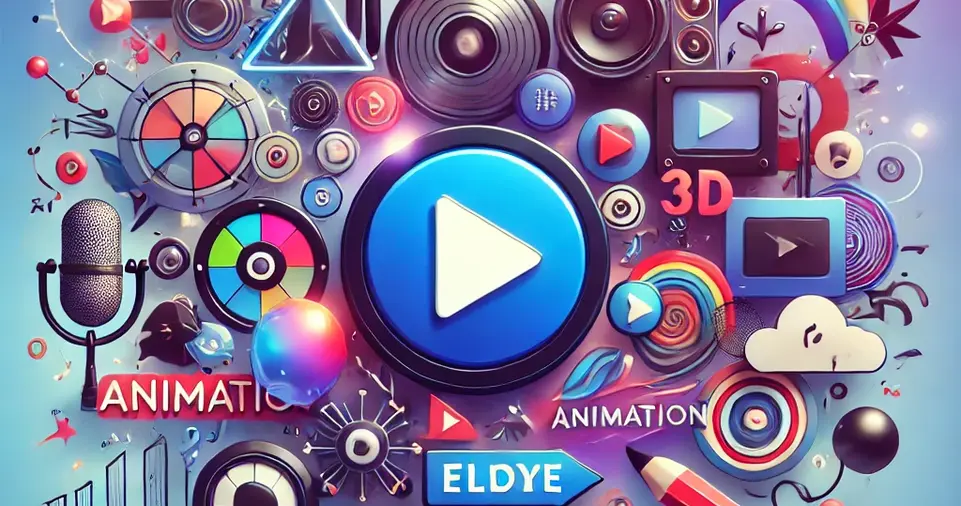Animation is a powerful storytelling tool that allows you to convey complex ideas, emotions, and messages in a way that is engaging, memorable, and visually appealing.
Whether you’re working on a marketing campaign, a YouTube video, an educational tool, or a brand project, the style of animation you choose can have a significant impact on how your message is received by your audience.
However, selecting the right animation style can be a daunting task.
With so many different types of animation styles available, each with its unique characteristics, it’s crucial to make an informed decision based on the objectives of your project.
Choosing the wrong style can lead to confusion, disengagement, or a failure to resonate with your target audience.
On the other hand, the right animation style can elevate your project, make it more impactful, and help it stand out from the crowd.
This comprehensive guide will walk you through the process of selecting the perfect animation style by exploring the key factors to consider, such as your project’s message, target audience, budget, and timeline.
Whether you’re creating an explainer video, a promotional animation, or a full-scale animated film, the insights shared in this guide will help you choose the ideal animation style for your project’s success.
Understanding Animation Styles
When it comes to animation, the style you choose will influence how your audience perceives your message.
Animation can range from simple line drawings to complex 3D worlds, and everything in between.
Each animation style has its own visual language, emotional impact, and effectiveness depending on the type of project you’re working on.
Therefore, it’s important to understand the different animation styles and their uses.
Types of Animation Styles
2D Animation
2D animation, also known as flat animation, is one of the most common and traditional forms of animation.
It involves the creation of characters and scenes in two dimensions:
- Height
- Width
This style has a simplistic, yet highly effective, visual approach and is often used for explainer videos, cartoons, and educational content.
- Pros: Cost-effective, faster production time, and versatile. It’s also great for storytelling, as it allows for clear character development and easy communication of ideas.
- Cons: Limited depth and realism. It might not be the best choice for projects that require intricate designs or complex visuals.
3D Animation
3D animation is a more advanced and modern style that involves creating three-dimensional models and scenes.
It’s used for projects that require a higher level of realism and depth, such as video games, movies, and corporate presentations.
- Pros: Stunning visual depth and realism. Great for projects that need to show intricate details or complex visual effects.
- Cons: More expensive and time-consuming to produce. Requires specialized skills and software.
Stop Motion Animation
Stop-motion animation is a technique where objects are physically manipulated and photographed frame by frame to create the illusion of movement.
This style gives projects a unique, handmade, and often nostalgic feel. It’s commonly used for independent films, short clips, and artistic projects.
- Pros: Unique, tactile feel. Adds a personal and artistic touch to your project.
- Cons: Very time-consuming and labor-intensive. Requires careful attention to detail and may not be suitable for larger-scale projects.
Motion Graphics
Motion graphics involve animated graphic design elements, such as text, shapes, and icons, to convey information in a dynamic and engaging way.
This style is frequently used in explainer videos, promotional content, and data visualization.
- Pros: Highly effective for presenting information in a clear, concise, and visually engaging way.
- Cons: May lack the emotional depth of character-driven animation styles. Best suited for informative rather than narrative-driven content.
Whiteboard Animation
Whiteboard animation uses illustrations that appear to be drawn on a whiteboard or paper, often accompanied by a voiceover.
This style is typically used for educational videos, tutorials, and explainer videos where the focus is on simplifying complex ideas.
- Pros: Clear, easy-to-follow visuals. Great for educational content, tutorials, or breaking down complex concepts.
- Cons: Can feel repetitive or monotonous if not executed creatively. Limited in terms of narrative depth.
Kinetic Typography
Kinetic typography is the art of animating text in a way that enhances its meaning, often used to express music lyrics, quotes, or powerful statements.
The text appears to move, shift, and change to create a dynamic and emotional experience.
- Pros: Engages the audience with text-driven content, ideal for music videos, quotes, or powerful messaging.
- Cons: Best suited for projects that focus on the message rather than visual storytelling. It may not be effective for projects that require character-driven narratives.
ALSO READ: How Long Does It Take to Make an Animation? A Beginner’s Guide to Production Time
Factors to Consider When Choosing an Animation Style

Now that you’re familiar with the different animation styles, let’s dive into the key factors you should consider when choosing the right one for your project.
Project’s Message and Tone
The first step in choosing the right animation style is to consider the message and tone of your project.
Are you delivering a serious, informative message, or are you trying to entertain and engage your audience?
The style of animation you choose should reflect the nature of the message you’re conveying.
For Serious or Informative Content
If your project is meant to convey serious, educational, or corporate information, you’ll want to choose an animation style that reflects professionalism and clarity.
Motion graphics and whiteboard animation are perfect for explainer videos or corporate presentations, as they allow you to simplify complex ideas and present them in an easily digestible format.
For Fun and Playful Content
If your project has a more casual, playful, or entertaining tone, styles like cartoon animation, stop motion, or 2D character animation may work best.
These styles allow for more creativity and can help engage a broader audience, especially younger viewers.
For Emotional or Dramatic Content
If you’re aiming for emotional depth or dramatic storytelling, 2D animation or 3D animation with expressive characters and detailed environments can help capture the audience’s attention and immerse them in the story.
These styles can bring complex emotions to life and are ideal for longer narratives or projects that require a deeper connection with the audience.
Understanding Your Target Audience
Your target audience plays a significant role in the type of animation you choose.
Different animation styles resonate with different demographics, so it’s important to consider the age, interests, and preferences of your audience.
Younger Audiences
If your project is aimed at children or young adults, you may want to choose a style that is visually appealing and engaging.
Cartoon-style animation, stop motion, or 2D character animation are great options for this demographic, as they are colorful, fun, and easy to follow.
Corporate and Professional Audiences
For a more mature, professional audience, styles like motion graphics, 2D animation, or 3D animation may be more appropriate.
These styles can convey a sense of professionalism and sophistication, making them perfect for business presentations, corporate videos, or technology-related projects.
Niche or Creative Audiences
If you’re targeting a niche audience or a creative community, consider using unique and artistic styles like hand-drawn animation, experimental animation, or stop motion.
These styles are visually distinctive and can help set your project apart from the competition.
Budget and Timeline
Another crucial factor in choosing an animation style is your project’s budget and timeline.
Some animation styles are more resource-intensive than others, and you’ll need to consider how much time and money you’re willing to invest in the production process.
Cost-Effective Animation
If you have a limited budget or timeline, 2D animation, motion graphics, and whiteboard animation are great choices.
These styles are less expensive and quicker to produce, especially if you’re working with a small team or limited resources.
High-End Animation
If your project allows for a higher budget and you have more time to work with, you might consider 3D animation, stop-motion, or even a fully animated film.
These styles are more labor-intensive and require specialized skills, but they can produce stunning results and provide a more immersive experience.
The Complexity of the Project
The complexity of your project will also impact the animation style you choose.
If you’re creating a simple explainer video, a clean motion graphics style or whiteboard animation might be sufficient.
However, if you’re working on a feature-length animated film or a more detailed commercial, you may need to choose a more sophisticated style, like 3D animation or 2D character animation.
Simpler Projects
For simpler projects that don’t require complex narratives or visuals, motion graphics, kinetic typography, or 2D animation are excellent options.
These styles allow you to quickly convey your message without overwhelming your audience.
Complex Projects
If you’re working on a larger-scale project, such as a full-length animated film, video game, or highly detailed advertisement, you may need to opt for 3D animation or a more intricate 2D animation style that provides the depth and realism necessary to tell your story effectively.
Visual Appeal and Aesthetic Fit
Finally, consider the visual appeal and aesthetic fit of the animation style for your project.
You’ll want to select a style that complements the overall look and feel of your project, whether you’re aiming for a sleek, modern design or a more artistic, handmade approach.
Minimalist and Sleek Designs
For modern, corporate, or tech-focused projects, flat design, motion graphics, or minimalist animation can provide a clean, professional aesthetic that is visually striking and easy to understand.
Artistic and Creative Designs
For creative or artistic projects, styles like hand-drawn animation, stop-motion, or illustrative animation can give your work a unique, personalized feel.
These styles are great for expressing creativity and making your project stand out.
Longevity and Adaptability
When choosing an animation style, it’s important to think about its long-term appeal.
Some animation styles, like motion graphics or flat design, tend to have a timeless quality that can be used for a variety of projects without feeling outdated.
On the other hand, more trendy animation styles may have a shorter shelf life and may not hold up as well over time.
ALSO READ: The Role of Sound in Animation: Why Music and Sound Effects Matter
Conclusion
Choosing the right animation style for your project is a critical decision that can make or break your project’s success.
By considering factors like the message you want to convey, your target audience, the complexity of the project, your budget, and the aesthetic you want to achieve, you can select an animation style that aligns with your goals.
Whether you opt for the simplicity of 2D animation, the depth of 3D animation, the creativity of stop-motion, or the elegance of motion graphics, the key is to ensure that the style enhances the effectiveness of your message and connects with your audience.
With the right animation style, you can bring your ideas to life in a way that captivates, educates, and entertains.

